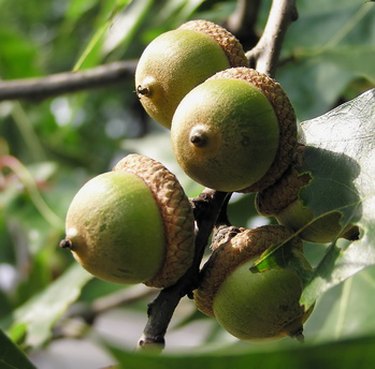
Worldwide, there are more than 600 different species of oak trees (Quercus spp.). Native to the woodlands and scrub lands of the Northern Hemisphere, they can be deciduous or evergreen, but all produce similar flowers in structure that yield hard, dry fruits called acorns. While a few oak species grow more like shrubs, the vast majority become upright, tall trees that require ample space in the landscape to mature to their fullest size and potential.
Environmental Improvements
Video of the Day
Oaks, as well as other trees, can improve environmental conditions in a landscape. The tree casts shade to cool the ground, blocks or diminishes wind that filters through its branches and foliage and can help stabilize soil with its root system. These benefits can be capitalized with reduced energy costs via lower winter heating or summer cooling bills as suggested by North Carolina State University.
Video of the Day
Wildlife
Acorns are a high-protein food source for a wide array of wildlife, from songbirds and game birds to rodents and various large mammals like bears and deer, according to the University of Florida. Moreover, the oak tree itself acts as a habitat, providing cover for birds and tree-dwelling critters. While humans can benefit from the shade or reduced wind from an oak tree, animals can also benefit from the protection of the tree in the local habitat.
Renewable Wood Resource
Oak wood is prized for its hardness, density and durability, and carpenters use its lumber for building beams, furniture and cabinetry. All trees are renewable, since more seedlings can be planted to replace the old fallen tree. These will mature for future generations to harvest and use for construction.
Ornamentation
Oak trees can simply provide garden ornamentation. The stately, structured branching architecture of an oak makes a handsome silhouette in the winter, and the often lobed leaves of an oak are among the leaves a child can easily recognize. In autumn, the leaves typically attain rich colors of gold, orange and russet red and become tan before eventually falling to the ground, where they are slow to decompose. Acorns that drop are also an ornate feature of the oak tree.